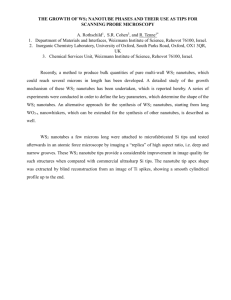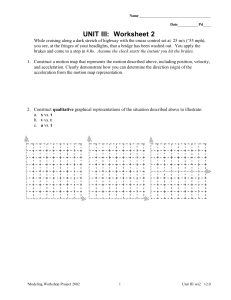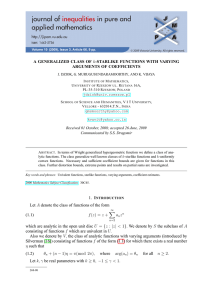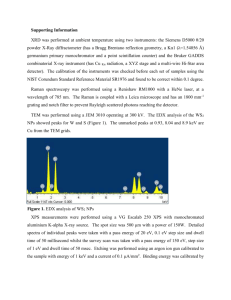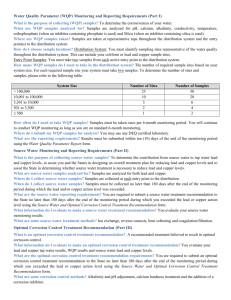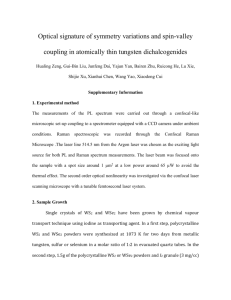Bulletin of Mathematical Analysis and Applications ISSN: 1821-1291, URL:
advertisement
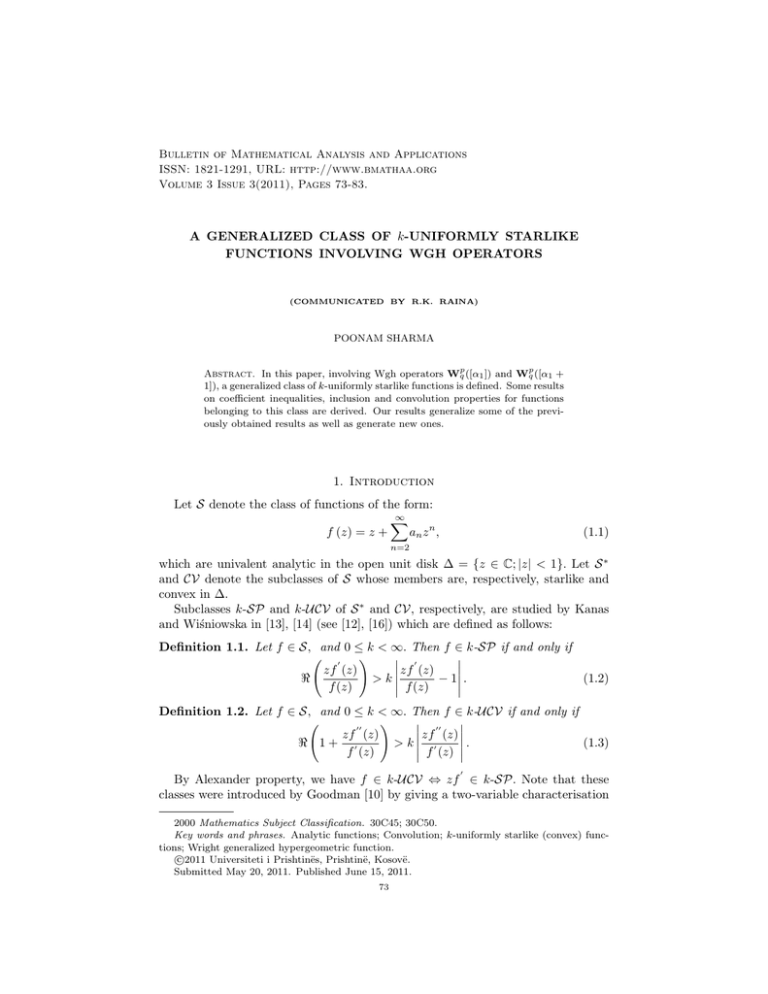
Bulletin of Mathematical Analysis and Applications
ISSN: 1821-1291, URL: http://www.bmathaa.org
Volume 3 Issue 3(2011), Pages 73-83.
A GENERALIZED CLASS OF k-UNIFORMLY STARLIKE
FUNCTIONS INVOLVING WGH OPERATORS
(COMMUNICATED BY R.K. RAINA)
POONAM SHARMA
Abstract. In this paper, involving Wgh operators Wqp ([α1 ]) and Wqp ([α1 +
1]), a generalized class of k-uniformly starlike functions is defined. Some results
on coefficient inequalities, inclusion and convolution properties for functions
belonging to this class are derived. Our results generalize some of the previously obtained results as well as generate new ones.
1. Introduction
Let S denote the class of functions of the form:
∞
∑
f (z) = z +
an z n ,
(1.1)
n=2
which are univalent analytic in the open unit disk ∆ = {z ∈ C; |z| < 1}. Let S ∗
and CV denote the subclasses of S whose members are, respectively, starlike and
convex in ∆.
Subclasses k-SP and k-UCV of S ∗ and CV, respectively, are studied by Kanas
and Wiśniowska in [13], [14] (see [12], [16]) which are defined as follows:
Definition 1.1. Let f ∈ S, and 0 ≤ k < ∞. Then f ∈ k-SP if and only if
′
( ′
)
zf (z)
zf (z)
ℜ
> k
− 1 .
(1.2)
f (z)
f (z)
Definition 1.2. Let f ∈ S, and 0 ≤ k < ∞. Then f ∈ k-UCV if and only if
′′
)
(
′′
zf (z) zf (z)
> k ′
ℜ 1+ ′
(1.3)
.
f (z) f (z)
′
By Alexander property, we have f ∈ k-UCV ⇔ zf ∈ k-SP. Note that these
classes were introduced by Goodman [10] by giving a two-variable characterisation
2000 Mathematics Subject Classification. 30C45; 30C50.
Key words and phrases. Analytic functions; Convolution; k-uniformly starlike (convex) functions; Wright generalized hypergeometric function.
c
⃝2011
Universiteti i Prishtinës, Prishtinë, Kosovë.
Submitted May 20, 2011. Published June 15, 2011.
73
74
P. SHARMA
of 1-UCV. Rønning [20] and independently Ma and Minda [17] have given a more
applicable one-variable characterisation for this class.
Geometrically, the class k-SP (k-UCV) is described as the family of functions f
′
′′
(z)
(z)
such that p(z) = zff (z)
(1 + zff ′ (z)
) is subordinate to the univalent functions pk
such that pk (∆) describe a conic region:
{
}
√
Ωk = u + iv : u > k (u − 1)2 + v 2 ,
(1.4)
with 1 ∈ Ωk . Some
( explicit form of extremal functions p)k are given in [12].
αi
For αi ∈ C A
̸= 0, −1, −2, ..., Ai > 0; i = 1, 2, ..., p and
i
(
)
q
p
∑
∑
βi
βi ∈ C B
=
̸
0,
−1,
−2,
...,
B
>
0;
i
=
1,
2,
...,
q
such
that
1+
B
−
Ai ≥ 0,
i
i
i
i=1
i=1
Wright’s generalized hypergeometric (Wgh) function p ψq [z] [24] ([23]) is defined
by
p
∏
[
] ∑
Γ (αi + nAi ) n
∞
z
(αi , Ai )1,p
i=1
,
(1.5)
ψ
[z]
=
ψ
;
z
=
p q
p q
q
∏
(βi , Bi )1,q
n!
n=0
Γ (βi + nBi )
i=1
which is analytic for bounded values of |z| . Involving Wgh function defined by (1.5)
with αi ̸= 0, −1, −2, ..., i = 1, 2, ..., p and βi ̸= 0, −1, −2, ..., i = 1, 2, ..., q, a linear
operator: Wqp ([α1 ]) = Wqp ((αi , Ai )1,p ; (βi , Bi )1,q ) : S → S is defined with the use
of convolution ∗ for f of the form (1.1) by
q
∏
Wqp ([α1 ])f (z)
=
z
[
Γ (βi )
i=1
p
∏
p ψq
Γ (αi )
=
i=1
∞
∑
z+
]
(αi , Ai )1,p
; z ∗ f (z)
(βi , Bi )1,q
(1.6)
an θn z n , z ∈ ∆,
n=2
where
p
∏
Γ(αi +(n−1)Ai )
θn =
i=1
q
∏
i=1
Γ(αi )
1
, n ≥ 2.
(n − 1)!
(1.7)
)
∞ (
∑
(n − 1)A1
an θn z n .
1+
α
1
n=2
(1.8)
Γ(βi +(n−1)Bi )
Γ(βi )
Also, we get
Wqp ([α1 + 1])f (z) := z +
We call the operators Wqp ([α1 ]) , Wqp ([α1 +1]) as the Wgh operators. Note that the
operator Wqp ([α1 ]) was defined by Dziok and Raina in [6] and was used in several
works, see [1], [2], [4], [5], [6], [7], [18], [19], [22].
Taking Ai = 1 (i = 1, 2, .., p) and Bi = 1 (i = 1, 2, .., q) , Wgh operator Wqp ([α1 ])
reduces to the Dziok-Srivastava operator Fpq ([α1 ]) ([8]) which is defined for f ∈ S
by
Fpq ([α1 ])f (z) = z p Fq [z] ∗ f (z),
A GENERALIZED CLASS OF k-UNIFORMLY STARLIKE FUNCTIONS
75
where p Fq [z] is the generalized hypergeometric function:
p Fq
[z] =
p Fq
(α1 , . . . αp ; β1 , . . . βq ; z)
p
∏
(αi )n n
∞
∑
z
i=1
=
, p ≤ 1 + q.
q
∏
n!
n=0
(βi )n
i=1
The symbol (λ)n is the Pochhammer symbol. Operator F21 ([α1 ]) is called the Hohlov
operator [11], F21 (α1 , 1; β1 ) is the Carlson and Shaffer operator [3] and F21 (1+λ, 1; 1)
is the Ruscheweyh derivative operator [21] which is defined for f ∈ S by
z
Dλ f (z) =
∗ f (z), λ > −1.
1+λ
(1 − z)
We define here a new class UC(k, [α1 ]) involving Wgh operators Wqp ([α1 ]) and
Wqp ([α1 + 1]):
Definition 1.3. Let Wgh operators Wqp ([α1 ]) and Wqp ([α1 +1]) be defined by (1.6)
and (1.8), respectively, then for 0 ≤ k < ∞, a function f ∈ S is said to be in the
class UC(k, [α1 ]) if it satisfies
p
)
( p
Wq ([α1 + 1])f (z)
Wq ([α1 + 1])f (z)
.
>
k
−
1
ℜ
(1.9)
p
p
Wq ([α1 ])f (z)
Wq ([α1 ])f (z)
On taking p = q + 1 and Ai = 1 (i = 1, 2, ..., p) , αi = βi = Bi = 1 (i = 1, 2, ..., q)
and if αq+1 = 1 + λ, λ > −1, class UC(k, [α1 ]) reduces to the class UK(λ, k) which
involve the Ruscheweyh derivative operators Dλ and Dλ+1 and is studied by Kanas
and Yaguchi [12]. Clearly, if p = q + 1 and αi = Ai = 1 (i = 1, 2, ..., p), βi = Bi =
1 (i = 1, 2, ..., q), then the class UC(k, [α1 ]) reduces to the class k-SP and also to
′
the class k-UCV if we replace f by zf in (1.9).
The purpose of this paper is to find some results for the class UC(k, [α1 ]) which
is defined by using its subordinate condition. Coefficient inequalities, inclusion and
convolution properties for this class are derived with some of the consequent results.
2. Coefficient Inequalities
α1
Theorem 2.1. Let Wqp ([α1 ]) be the Wgh operator defined by (1.6) with A
≥
1
1, and if for 0 ≤ k < ∞, the function f of the form (1.1) belongs to the class
UC(k, [α1 ]), then there exists a convex univalent function:
pk (z) =
Wqp ([α1 + 1])fk (z)
, z ∈ ∆,
Wqp ([α1 ])fk (z)
fk (z) = z + d2 z 2 + d3 z 3 + ... such that
|a2 | ≤ |d2 | , |a3 | ≤ |d3 | .
(2.1)
Proof. Let f ∈ UC(k, [α1 ]), we get
p(z) ≺ pk (z), z ∈ ∆,
where
p(z) =
Wqp ([α1 + 1])f (z)
= 1 + p1 z + p2 z 2 + ...
Wqp ([α1 ])f (z)
(2.2)
(2.3)
76
P. SHARMA
and
pk (z) =
Wqp ([α1 + 1])fk (z)
= 1 + P1 z + P2 z 2 + ...(Pj ≥ 0, j = 1, 2, ...).
Wqp ([α1 ])fk (z)
(2.4)
On writing the series expansions of Wqp ([α1 ])f (z), Wqp ([α1 + 1])f (z) and
Wqp ([α1 ])fk (z), Wqp ([α1 + 1])fk (z), equations (2.3) and (2.4) provide
)
(
)
∞
∞ (
∑
∑
(
)
A1
2
n
1 + p1 z + p2 z + .. z +
an θn z
=z+
1 + (n − 1)
an θn z n
α
1
n=2
n=2
(2.5)
and
(
)
)
∞
∞ (
∑
∑
(
)
A1
2
n
1 + P1 z + P2 z + .. z +
dn θn z
=z+
1 + (n − 1)
dn θn z n .
α
1
n=2
n=2
(2.6)
Hence, from (2.5) and (2.6), we get the coefficient relations:
(m − 1)
and
(m − 1)
m−1
∑
A1
am θm =
pj am−j θm−j , m ≥ 2
α1
j=1
(2.7)
m−1
∑
A1
dm θm =
Pj dm−j θm−j , m ≥ 2,
α1
j=1
a1 = d1 = θ1 = 1. Hence, we obtain
A1
A1
α1 2
θ2 a2 = p1 , 2 θ3 a3 =
p + p2
(2.8)
α1
α1
A1 1
and
A1
A1
α1 2
θ2 d2 = P1 , 2 θ3 d3 =
P + P2 .
(2.9)
α1
α1
A1 1
As Pj ≥ 0, j = 1, 2, .. , from (2.9), it is clear that θ2 d2 and θ3 d3 are also non-negative
real numbers. Further, with the use of subordination (2.2), we get p(z) = pk (w(z))
for some analytic function w with w(0) = 0 and |w(z)| < 1, z ∈ ∆. If w(z) = q(z)−1
q(z)+1 ,
where q(z) = 1 + q1 z + q2 z 2 + ..., with ℜ (q(z)) > 0, we write
(
)
q(z) − 1
p(z) = pk
.
q(z) + 1
On using their series expansions, we obtain
(
)
P1 q1
P1 q 2
P1 q12
P2 q12
2
1 + p1 z + p2 z + .. = 1 +
z+
−
+
z 2 + ...
2
2
4
4
Thus, by (2.8), (2.9) and (2.10), we get
A1
θ2 a2 = |p1 | = P1 q1 ≤ |P1 | = A1 θ2 d2 2 α1
α1
and
2A1
α1 θ3 a3 (
)
α1
2
2
= − 1 p1 + p2 + p1 A1
(
)
2A1
α1
2
2
≤
− 1 P1 + P2 + P1 = θ3 d3 ,
A1
α1
(2.10)
(2.11)
(2.12)
A GENERALIZED CLASS OF k-UNIFORMLY STARLIKE FUNCTIONS
77
2
where we use the inequalities |qn | ≤ 2, n ≥ 1 and |p2 | + |p1 | ≤ P2 + P12 ([15]).
Thus, inequalities (2.11) and (2.12) imply the desired result (2.1). This proves
Theorem 2.1.
α1
Theorem 2.2. Let Wqp ([α1 ]) be the Wgh operator defined by (1.6) with A
≥ 1,
1
if the function f of the form (1.1) belongs to the class UC(k, [α1 ]) for 0 ≤ k < ∞,
then there exists a convex univalent function:
pk (z) =
Wqp ([α1 + 1])fk (z)
= 1 + P1 z + P2 z 2 + ...(Pj ≥ 0, j = 1, 2, ...),
Wqp ([α1 ])fk (z)
such that
(
)
P1 1 + α1 P1
A1
A1
n−2
θn an ≤
, n ≥ 2,
α1
(n − 1)!
where θn is given by (1.7).
Proof. By induction, it is shown by Theorem 2.1 that result holds for n = 2. Let
the result be true for all j, 2 ≤ j ≤ n − 1. Thus, from coefficient relation (2.7) and
by Rogosinski result |pj | ≤ P1 , j = 1, 2, .., we get
n−1
A1
∑
(n − 1) an θn = pn−j aj θj , n ≥ 2
α1
j=1
≤ P1 +
n−1
∑
|pn−j | |aj θj |
j=2
≤ P1 1 +
n−1
∑
α1
A 1 P1
(
(j − 1)!
j=2
We see that
1+
n−1
∑
α1
A1 P1
=
=
=
1
1!
1+
1+
α1
P1
A1
)
+
n−1
∑
1+
j−2
.
(2.13)
j−2
α1
A1 P1
(
α1
α1
P1
2+
P1
A1
A1
(
)
1
α1
1+
P1
.
(n − 2)!
A1
n−2
1
2!
)
)
j=3
)(
(
α1
A1 P1
(j − 1)!
j=2
(
(
α1
A1 P1
1+
1+
α1
A1 P1
)
j−2
(j − 1)!
)
+
n−1
∑
j=4
α1
A1 P1
(
1+
α1
A1 P1
)
j−2
(j − 1)!
Hence, (2.13) proves that the result is true for n also. Thus the result holds for any
n ≥ 2. This proves Theorem 2.2.
′
Replacing f by zf , we can obtain following result on the similar lines of the
proofs of Theorems 2.1 and 2.2:
78
P. SHARMA
Theorem 2.3. Let Wqp ([α1 ]) be the Wgh operator defined by (1.6) with
and if for 0 ≤ k < ∞, the function f of the form (1.1) satisfies
α1
A1
≥ 1,
′
′
Wqp ([α1 + 1]) zfk (z)
Wqp ([α1 + 1]) zf (z)
≺
′
′
p
Wq ([α1 ]) zf (z)
Wqp ([α1 ]) zfk (z)
then for fk (z) = z + d2 z 2 + d3 z 3 + ... and for
′
Wqp ([α1 + 1]) zfk (z)
= 1 + P1 z + P2 z 2 + ...(Pj ≥ 0, j = 1, 2, ...),
′
Wqp ([α1 ]) zfk (z)
|a2 | ≤ |d2 | , |a3 | ≤ |d3 |
(
)
P1 1 + α1 P1
A1
A1
n−2
θn an ≤
, n ≥ 2, .
α1
n!
where θn is given by (1.7).
and
(2.14)
Theorem 2.4. If for the function f of the form (1.1) and for 0 ≤ k < ∞, θn given
by (1.7), the inequality
}
∞ {
∑
A1 (n − 1) (k + 1) + 1 |an θn | < 1
(2.15)
α1
n=2
holds, then f ∈ UC(k, [α1 ]).
Proof. To prove f ∈ UC(k, [α1 ]), we have to show from the condition (1.9) that
p
)
( p
Wq ([α1 + 1])f (z)
Wq ([α1 + 1])f (z)
S1 := k − 1 − ℜ
− 1 < 1.
Wqp ([α1 ])f (z)
Wqp ([α1 ])f (z)
From (1.6) and (1.8), we get
S1
p
Wq ([α1 + 1])f (z)
≤ (k + 1) −
1
p
Wq ([α1 ])f (z)
∞
∑
1
a
θ
(n − 1) A
n
n
α1
n=2
< 1,
≤ (k + 1)
∞
∑
1−
|an θn |
n=2
if (2.15) holds. This proves Theorem 2.4.
3. Inclusion Property
Wqp ([α1 ])
Theorem 3.1. Let
be the Wgh operator defined by (1.6) with 0 <
′
(k + 1), 0 ≤ k < ∞. Then zf (z) ∈ UC(k, [α1 ]) ⇒ f ∈ U C(k, [α1 ]).
α1
A1
<
′
Proof. Let zf (z) ∈ UC(k, [α1 ]), then there exists a univalent convex function
pk (z), z ∈ ∆ describing the conic region Ωk defined by (1.4) such that
′
Wqp ([α1 + 1]) zf (z)
≺ pk (z).
Wqp ([α1 ]) zf ′ (z)
Set
p(z) =
Wqp ([α1 + 1])f (z)
.
Wqp ([α1 ])f (z)
(3.1)
A GENERALIZED CLASS OF k-UNIFORMLY STARLIKE FUNCTIONS
79
(
)′
′
Note that z Wqp ([α1 ])f (z) = Wqp ([α1 ]) zf (z). Hence, differentiation of (3.1)
provides
′
′
′
Wqp ([α1 ]) zf (z) zp (z)
Wqp ([α1 + 1]) zf (z)
=
+
Wqp ([α1 + 1]) f (z)
Wqp ([α1 ]) f (z)
p(z)
Using the identity:
(
)
′
α1 p
α1
Wqp ([α1 ]) zf (z) =
Wq ([α1 + 1]) f (z) −
− 1 Wqp ([α1 ]) f (z),
A1
A1
we get
′
′
Wqp ([α1 + 1]) zf (z)
zp (z)
(
) ≺ pk (z).
=
p(z)
+
Wqp ([α1 ]) zf ′ (z)
p(z) α1 + 1 − α1
A1
A1
Therefore, by using a well known Lemma of Eenigenburg, Miller, Mocanu and Read
[9], we get
p(z) ≺ pk (z),
provided that
(
(
))
α1
α1
ℜ pk (z)
+ 1−
> 0.
A1
A1
Since, from the definition of Ωk , given by (1.4), we have ℜ (pk (z)) >
by the hypothesis we get the result.
k
k+1
and hence,
Remark. Above result confirms that k-UCV ⊂ k-SP.
4. Convolution Property
Theorem 4.1. Let Wqp ([α1 ]) be the Wgh operator defined by (1.6), then for 0 ≤
k < ∞, f ∈ UC(k, [α1 ]) if and only if
)
1(
(4.1)
Ht ∗ Wqp ([α1 ])f (z) ̸= 0, z ∈ ∆,
z
where
(
)
A1
1
−
1
−
α1 z
1
z
Ht (z) =
− C(t) , z ∈ ∆
(4.2)
(1 − C(t)) (1 − z)
(1 − z)
√
2
2
and C (t) = kt ± i t2 − (kt − 1) , t ≥ 0, t2 − (kt − 1) ≥ 0.
Proof. Let
Wqp ([α1 + 1])f (z)
, z ∈ ∆.
Wqp ([α1 ])f (z)
Since p(0) = 1, we have from the definition of conic region (1.4)
p(z) =
f ∈ UC(k, [α1 ]) ⇔ p(z) ∈
/ ∂Ωk , z ∈ ∆,
(4.3)
{
}
√
∂Ωk = u + iv : u = k (u − 1)2 + v 2 .
(4.4)
√
2
2
Note that ∂Ωk = C (t) = kt ± i t2 − (kt − 1) , for t ≥ 0, t2 − (kt − 1) ≥ 0.
Thus, we have
(
)
1 Wqp ([α1 + 1])f (z) − C (t) Wqp ([α1 ]) f (z)
̸= 0,
(4.5)
z
(1 − C(t))
where
80
P. SHARMA
By series expansions of Wqp ([α1 + 1])f (z) and Wqp ([α1 ])f (z), given in (1.8) and
(1.6), we note that
(
(
) )
1
z 1− 1− A
z
α
1
Wqp ([α1 + 1])f (z) =
∗ Wqp ([α1 ]) f (z)
(1 − z)2
and
Wqp ([α1 ]) f (z) =
z
∗ Wqp ([α1 ]) f (z).
(1 − z)
Hence, by (4.5), we get
)
1(
Ht ∗ Wqp ([α1 ])f (z)
z
(
) )
(
A1
z
1
−
1
−
z
α1
1
z
1
p
=
−
C
(t)
∗
W
([α
])f
(z)
̸= 0.
1
q
z (1 − C(t))
(1 − z)2
(1 − z)
Thus,
)
1(
/ ∂Ωk ⇔ p(z) ∈ Ωk , z ∈ ∆.
Ht ∗ Wqp ([α1 ])f (z) ̸= 0 ⇔ p(z) ∈
z
This proves the convolution property.
On taking p = q + 1 and αi = Ai = 1 (i = 1, 2, .., p) , βi = Bi = 1 (i = 1, 2, .., q) ,
in Theorem 4.1, we get following result for the class k-SP
Corollary 4.2. Let 0 ≤ k < ∞, then f ∈ k-SP , if and only if
1
(Gt ∗ f ) (z) ̸= 0, z ∈ ∆,
z
where
Gt (z) =
1
z
(1 − C(t)) (1 − z)
(
)
1
− C(t) , z ∈ ∆,
(1 − z)
√
2
2
C (t) = kt ± i t2 − (kt − 1) , t ≥ 0, t2 − (kt − 1) ≥ 0.
Note that for f, g ∈ S
(
g ∗ zf
′
)
( ′
)
(z) = zg ∗ f (z).
′
Hence, on replacing f by zf in Corollary 4.2, we get following result of Kanas and
Wiśniowska [[14], Theorem 3.5, p. 336] for the class k-UCV.
Corollary 4.3. [14] Let 0 ≤ k < ∞, then f ∈ k-UCV , if and only if
]
1[ ′
zGt ∗ f (z) ̸= 0,
z
where
(
)
′
1
z
1+z
zGt =
− C(t) , z ∈ ∆,
(1 − C(t)) (1 − z)2 1 − z
√
2
2
C (t) = kt ± i t2 − (kt − 1) , t ≥ 0, t2 − (kt − 1) ≥ 0.
Further, Theorem 4.1 yields following result of Kanas and Yaguchi [12]:
A GENERALIZED CLASS OF k-UNIFORMLY STARLIKE FUNCTIONS
81
Corollary 4.4. [12] Let 0 ≤ k < ∞ and λ > −1, then f ∈ U K(λ, k) if and only if
1
(Rt ∗ f ) (z) ̸= 0,
z
where
z
Rt (z) =
(1 − z)λ+2
(4.6)
(
)
C(t) z
1−
C(t) − 1
√
2
2
and C (t) = kt ± i t2 − (kt − 1) , t ≥ 0, t2 − (kt − 1) ≥ 0.
Proof. Applying the argument similar to the argument applied in the proof of
Theorem 4.1, we get
{
}
( λ+1
)
1
1
λ
f ∈ UK(λ, k) ⇔
D
f (z) − C (t) D f (z) ̸= 0.
z (1 − C(t))
Using the definition of Ruscheweyh derivative operators, we get
(
)
z
z
Dλ+1 f (z) − C (t) Dλ f (z) =
−
C
(t)
∗ f (z),
(1 − z)λ+2
(1 − z)λ+1
which proves the condition (4.6).
Theorem 4.5. Let Wqp ([α1 ]) be the Wgh operator defined by (1.6) with
then for 0 < k < ∞, f ∈ UC(k, [α1 ]) if and only if
)
1( p
Wq ([α1 ])Ht ∗ f (z) ̸= 0, z ∈ ∆,
z
where for Ht (z) given by (4.2),
Wqp ([α1 ])Ht (z) = z +
∞
∑
α1
A1
≥ 1,
(4.7)
hn z n , z ∈ ∆,
n=2
}
{
(n − 1)A1
(1 + k) |θn | , n ≥ 2,
|hn | ≤ 1 +
α1
θn is given by (1.7).
)
(
Proof. Mentioning the proof of Theorem 4.1 and the convolution property: Ht ∗ Wqp ([α1 ])f (z) =
( p
)
Wq ([α1 ])Ht ∗ f (z), we get
)
1( p
Wq ([α1 ])Ht ∗ f (z) ̸= 0, z ∈ ∆,
z
where the coefficient hn in the series expansion of Wqp ([α1 ])Ht (z) is given by
{(
)
}
α1
C(t) − n
A1
hn =
−1 +
θn .
A1
(C(t) − 1)
α1
C(t)−n Hence, maximum of |hn | for each n ≥ 2, depends upon the maximum of (C(t)−1)
.
Since,
(
)
C(t) − n 2
C(t)
−
n
= (
C(t) − n
)
(C(t) − 1) (C(t) − 1)
C(t) − 1
( 2
)
n −1
2k(n − 1)
+
:= s(t),
= 1−
t
t2
f ∈ UC(k, [α1 ]) ⇔
82
P. SHARMA
[
which decreases in the interval
t0 =
n+1
k .
)
1
k+1 , t0
2
and increases in (t0 , ∞) with a minima at
1
But s( k+1
) = [n + k(n − 1)] > 1. Thus,
[(
)
]
α1
A1
− 1 + n + k(n − 1)
|θn | .
|hn | ≤
A1
α1
This proves the result of Theorem 4.5.
Corollary 4.6. The function g(z) = z + Cz n ∈ UC(k, [α1 ]) if and only if
|C| ≤ {
1
1+
(n−1)A1
(1
α1
}
, n ≥ 2,
+ k) |θn |
(4.8)
θn is given by (1.7).
Proof. Let (4.8) holds. To prove the result by Theorem 4.5, we have to show
S2 :=
Since,
)
1( p
Wq ([α1 ])Ht ∗ g (z) ̸= 0, z ∈ ∆.
z
|S2 | = 1 + hn C z n−1 > 1 − |hn C z| ≥ 1 − |z| > 0, z ∈ ∆.
This proves g ∈ UC(k, [α1 ]). Conversely, let g ∈ UC(k, [α1 ]) and let
}
∞ {
∑
(n − 1)A1
Wqp ([α1 ])H(z) = z +
(1 + k) |θn | z n .
1+
α1
n=2
Then
{
}
)
1( p
(n − 1)A1
Wq ([α1 ])H ∗ g (z) = 1 + 1 +
(1 + k) |θn | C z n−1 , z ∈ ∆.
z
α1
Thus, if
|C| > {
1+
1
(n−1)A1
(1
α1
then there exists a point ζ ∈ ∆ such that
that the inequality (4.8) must hold.
1
ζ
}
,
+ k) |θn |
( p
)
Wq ([α1 ])H ∗ g (ζ) = 0. This proves
5. Concluding Remark
It is noted that taking Ai = 1 (i = 1, 2, .., p) and Bi = 1 (i = 1, 2, .., q) , in our
results (obtained in previous Sections 2-4), similar results can also be derived for
Dziok-Srivastava operators Fpq ([α1 ]) and Fpq ([α1 + 1]) and for the special cases of
these operators discussed in Introduction. In fact, involving Ruscheweyh derivative
operators Dλ f (z) and Dλ+1 f (z), some of the results have been obtained by Kanas
and Yaguchi in [12]. Also, our results verify some of the results of Kanas and
′
Wiśniowska [13] for the class k-SP and also for k-UCV [14] if f is replaced by zf .
Acknowledgments. The author would like to thank the anonymous referee and
the BMATHAA Editor: Professor R.K. Raina for their several useful suggestions
for the improvement of this article.
A GENERALIZED CLASS OF k-UNIFORMLY STARLIKE FUNCTIONS
83
References
[1] M.K. Aouf, J. Dziok, Distortion and convolutional theorems for operators of generalized
fractional calculus involving Wright function, J. App. Anal. 14 (2) (2008), 183–192.
[2] M.K. Aouf, J. Dziok, Certain class of analytic functions associated with the Wright generalized hypergeometric function, J. Math. Appl. 30 (2008), 23–32.
[3] B.C. Carlson, D.B. Shaffer, Starlike and prestarlike hypergeometric functions, SIAM J. Math.
Anal. 15 (4) (1984), 737–745.
[4] J. Dziok, G. Murugusundaramoorthy, K. Vijaya, A generalized class of k-starlike functions
with varying arguments of coefficients, J. Inequal. Pure Appl. Math. 10 (3) Art. 66 (2009) 9
pp.
[5] J. Dziok, R.K. Raina, Extremal problems in the class of analytic functions associated with
Wright’s function, Advan. Pure Appld. Math. 1 (2) (2010), 247–258.
[6] J. Dziok, R.K. Raina, Families of Analytic functions associated with the Wright generalized
hypergeometric functions, Demonstratio Math. 37 (3) (2004), 533–542.
[7] J. Dziok, R.K. Raina, Some results based on first order differential subordination with
the Wright’s generalized hypergeometric function, Comment. Math. Univ. St. Pauli. 58 (2)
(2009), 87–94.
[8] J. Dziok, H.M. Srivastava, Classes of analytic functions associated with the generalized hypergeometric functions, Appl. Math. Comput. 103 (1999), 1–13.
[9] P. Eeingenburg, S.S. Miller, P.T. Mocanu, M.D. Reade, On a Briot-Bouquet differential subordination, General Inequalities, International Series of Numerical Mathematics, Birkhäuser
Verlag, Basel, 64, (3) (1983), 339–348.
[10] A.W. Goodman, On uniformly convex functions, Ann. Polon. Math. 56 (1991), 87–92.
[11] YU. E. Hohlov, Operators and operations on the class of univalent functions, Izv. Vyssh.
Uchebn. Zaved. Mat. 10 (1978), 83–89.
[12] S. Kanas, T. Yaguchi, Subclasses of k-uniformly convex and starlike functions defined by
generalized derivative, II, Publ. l’Inst. Math. 69 (83) (2001), 91–100.
[13] S. Kanas, A. Wiśniowska, Conic regions and k-uniformly starlike functions, Rev. Roumaine
Math. Pures Appl. 45 (4) (2000), 647–657.
[14] S. Kanas, A. Wiśniowska, Conic regions and k-uniform convexity, J. Comput. Appl. Math.
105 (1999), 327–336.
[15] S. Kanas, A. Wiśniowska, Conic regions and k-uniform convexity, II, Folia Sci. Tech. Resov.
170 (1998), 65–78.
[16] S. Kanas, H.M. Srivastava, Linear operators associated with k-uniformly convex functions,
Int. Transf. Spec. Func. 9 (2000), 121–132.
[17] W. Ma, D. Minda Uniformly convex functions, Ann. Polon. Math. 57 (1992), 165–175.
[18] R.K. Raina, On generalized Wright’s hypergeometric functions and fractional calculus operators, East Asian Math. J. 21 (2) (2005), 191–203.
[19] R.K. Raina, P. Sharma, Harmonic univalent functions associated with Wright’s generalized
hypergeometric functions, Int. Transf. Spec. Func. (2011), To appear.
[20] F. Rønning, Uniformly convex functions and a corresponding class of starlike functions, Proc.
Amer. Math. Soc. 118 (1993), 189–196.
[21] S. Ruscheweyh, New criteria for univalent functions, Proc. Amer. Math. Soc. 77 (1979),
336–343.
[22] P. Sharma, A class of multivalent analytic functions with fixed argument of coefficients involving Wright’s generalized hypergeometric functions, Bull. Math. Anal. Appl. 2 (1) (2010),
56–65.
[23] H.M. Srivastava, H.L. Manocha, A Treatise on Generating Functions, Halsted Press (Ellis
Horwood Limited, Chichester) 1984.
[24] E.M. Wright, The asymptotic expansion of the generalized hypergeometric function, Proc.
London Math. Soc. 46 (1946), 389–408.
Poonam Sharma
Department of Mathematics & Astronomy University of Lucknow, Lucknow 226007 UP
India
E-mail address: sharma poonam@lkouniv.ac.in
